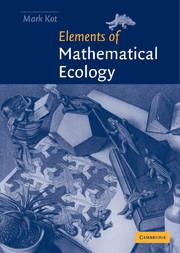Book contents
- Frontmatter
- Contents
- Preface
- Acknowledgments
- I UNSTRUCTURED POPULATION MODELS
- 1 Exponential, logistic, and Gompertz growth
- 2 Harvest models: bifurcations and breakpoints
- 3 Stochastic birth and death processes
- 4 Discrete-time models
- 5 Delay models
- 6 Branching processes
- 7 A classical predator-prey model
- 8 To cycle or not to cycle
- 9 Global bifurcations in predator–prey models
- 10 Chemostat models
- 11 Discrete-time predator–prey models
- 12 Competition models
- 13 Mutualism models
- 14 Harvest models and optimal control theory
- II STRUCTURED POPULATION MODELS
- References
- Author index
- Subject index
10 - Chemostat models
Published online by Cambridge University Press: 05 August 2012
- Frontmatter
- Contents
- Preface
- Acknowledgments
- I UNSTRUCTURED POPULATION MODELS
- 1 Exponential, logistic, and Gompertz growth
- 2 Harvest models: bifurcations and breakpoints
- 3 Stochastic birth and death processes
- 4 Discrete-time models
- 5 Delay models
- 6 Branching processes
- 7 A classical predator-prey model
- 8 To cycle or not to cycle
- 9 Global bifurcations in predator–prey models
- 10 Chemostat models
- 11 Discrete-time predator–prey models
- 12 Competition models
- 13 Mutualism models
- 14 Harvest models and optimal control theory
- II STRUCTURED POPULATION MODELS
- References
- Author index
- Subject index
Summary
The fascinating single-species models of Chapters 1 through 6 and the equally interesting predator–prey models of Chapters 8 and 9 can be an experimentalist's nightmare. The chief problem lies with the carrying capacity K. In principle, this is a fine parameter. It is the size (or density) at which a population's birth rate equals its death rate. It defines the capacity of the environment to ‘carry’ organisms. This is all fine and good, but how do you measure the carrying capacity for an organism - especially if the carrying capacity is unstable? Is there some way of predicting the asymptotic behavior of a population short of measuring the birth and death rates for a range of densities?
Many organisms are limited by their inability to procure or assimilate enough of some essential environmental nutrient. We will follow the strategy of constructing a resource-based model for these organisms. Such models have experimental advantages over the models that we considered earlier. As a result, they are of increasing importance in the ecological literature.
Resource-based models have their origins in models for growth in a chemostat. A chemostat is a common laboratory apparatus for the culture and growth of microorganisms. You pump sterile growth medium into the chemostat at a constant rate and you keep the volume within the chemostat constant by letting excess medium (and microbes) flow out through a siphon. By modeling the uptake of some essential limiting nutrient (substrate), you can predict the effective carrying capacity for the species. Limnologists and oceanographers have taken these simple resource-based models and used them to predict the nutrient, phytoplankton, and zooplankton densities in lakes and oceans.
- Type
- Chapter
- Information
- Elements of Mathematical Ecology , pp. 161 - 180Publisher: Cambridge University PressPrint publication year: 2001



